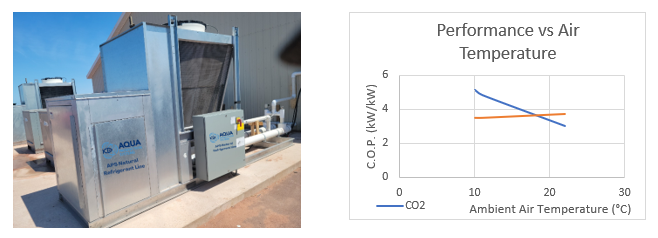PRACTICAL OBSERVATIONS IN REFRIGERATION FOR AQUACULTURE CHILLER AND HEAT PUMP SYSTEMS USING CARBON DIOXIDE AS A REFRIGERANT IN PLACE OF REFRIGERANTS WITH HIGHER GLOBAL WARMING POTENTIAL
Refrigeration to heat or cool water for land-based aquaculture often accounts for a significant portion of the capital expense, and the electrical energy operating expense. In recent years, refrigeration has also been flagged as a significant portion of the environmental footprint. This real-world case study was conducted to compare the performance and market reception of CO2 chillers alongside one of the most efficient conventional refrigerant chillers available. The findings, notes, and observations are presented here in an effort to help those who design and/or buy refrigeration equipment for aquaculture to make informed choices when evaluating refrigeration options for aquaculture operations.
Two of each chiller were constructed and installed in a live shellfish holding operation. Each chiller was supplied by an identical pump that solely serviced that chiller. An ultrasonic flow meter was used to measure flow rate. Water temperature was measured before and after each chiller always ensuring that the inlet and outlet temperature differential was calibrated to zero before the chiller was turned on.
What are believed to be t he first chillers in the world to use CO2 in a live seafood system were designed and built by a company in Nova Scotia, and commissioned in Prince Edward Island in 2022. Data shows that below the transcritical point the efficiency of the CO2 refrigerant is higher than conventional refrigerants. Above the transcritical point, the efficiency is reduced below the point of conventional refrigerants. Therefore, the verdict on efficiency of CO2 as compared with conventional refrigerants rests on the ambient temperature or the cooling water temperature which drive the ‘condensing temperature’ or compression ratio.
There are also market advantages to using CO2 as a refrigerant that are presented herein.
